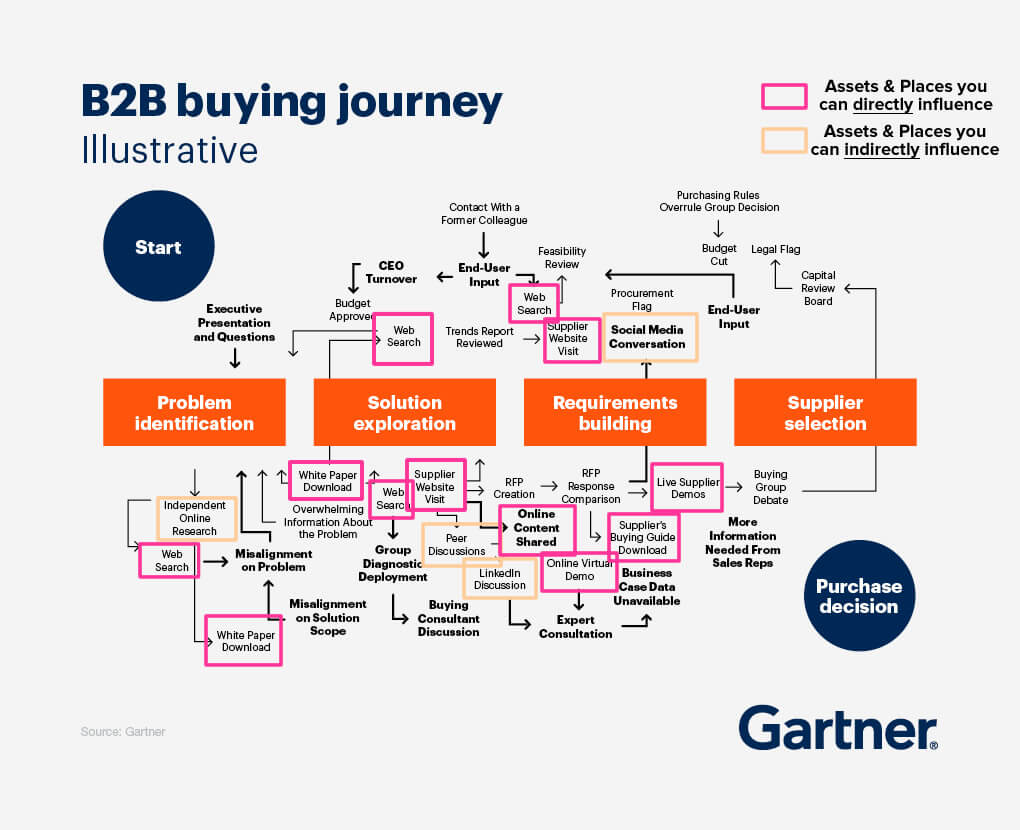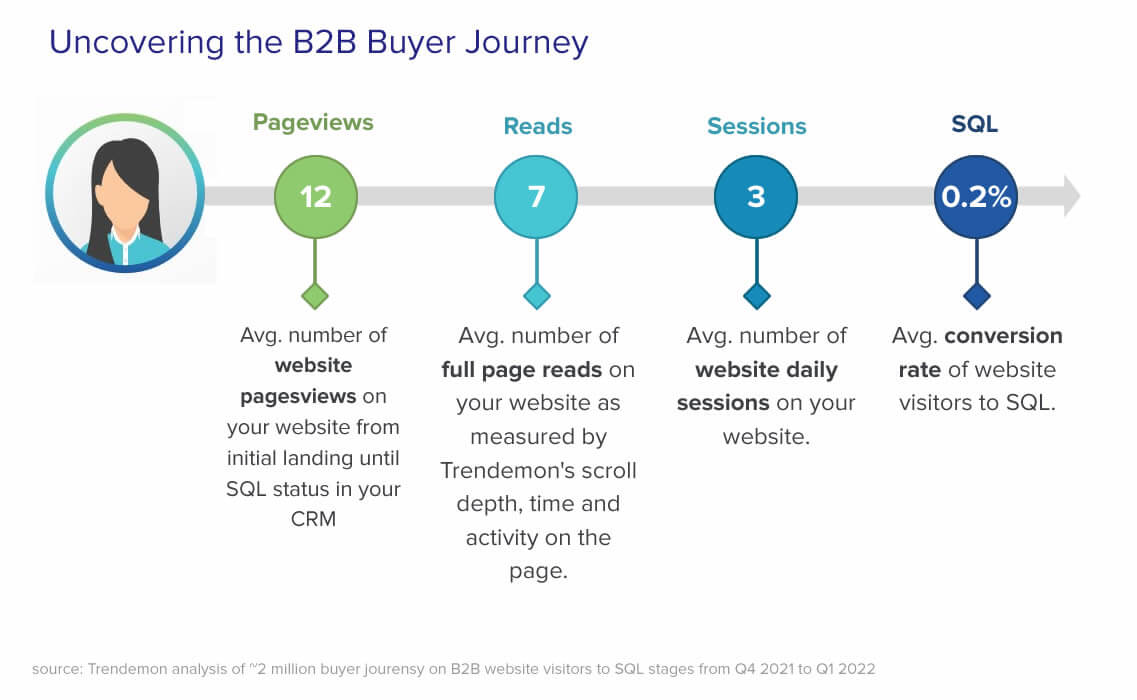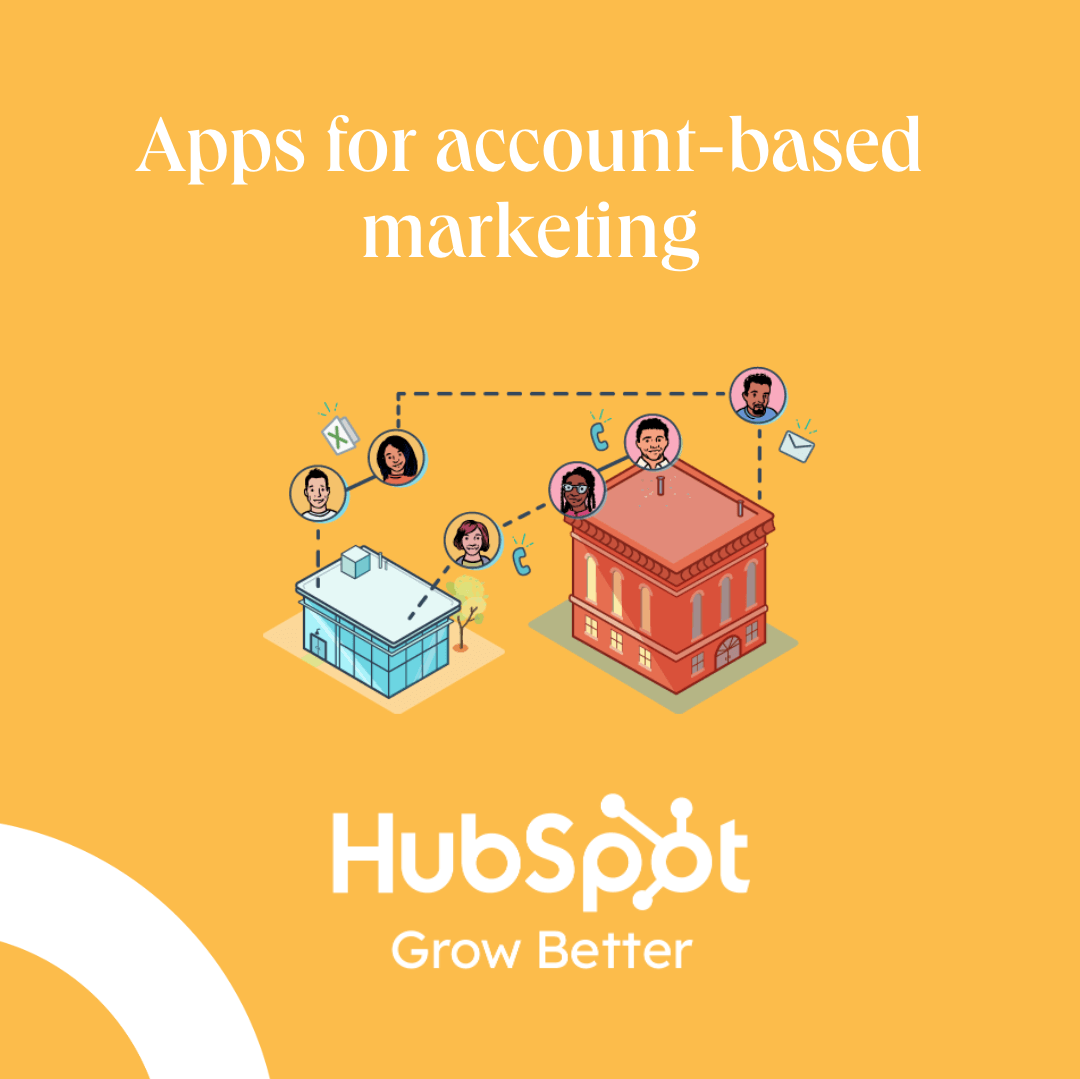The Journey: How many webpages does it take to convert to SQL?

In this edition of The Journey, we decided to take a closer look at the levels of interaction a typical B2B buyer has on your website. More specifically, how many touchpoints on average does it require to convert visitors into Sales Qualified Leads (SQL) or any other bottom of funnel goal. See our analysis below to uncover how many pageviews, reads and sessions do these journeys usually require. But before we dive in, why is it even a question we think that’s worth asking?
The Buyer-led Journey
A Gartner research found that 83% of the buyers’ time is spent researching independently or discussing internally, and only 17% talking with the supplier. With several suppliers, this comes down to 5%.
Here’s how Gartner visualizes the buyer journey stages, interactions and decision points for enterprise software:

Touchpoints on the website
Trendemon connects buyer journeys from the website to bottom-of-funnel goals like SQLs, closed won opportunities and even bottom line revenue. We wanted to see how many touchpoints on the individual user level it takes for a first time website visitor to reach SQL stage.

Key Takeaways From Our Data
- Your readers are your buyers: while the average number of pageviews (12) is not as huge as one would expect, the engagement levels (readership) by people reaching SQLs is very high = more than 50% of pages needs to be read in order to reach the goal. That is a great leading indicator of potential buyers. This also stresses the importance of having compelling and informative content to support your customers’ journeys (since half of your journey’s content would never get read anyway).
- Three strikes and you’re out: we were surprised by the relatively few sessions per user – that means you have a very limited opportunity to capture the attention and engage your buyer on your website before they make a decision to contact sales.
- Every session must score: data shows it is unlikely you will have a 4th chance to convert your visitors into SQLs, therefore you must invest in the 3 sessions your audience is reading your content. One validated way to increase your chances is by incorporating personalization throughout your webpages.
- The attention economy: When we conducted a similar review about 2 years ago, the overall engagement figures were ~30% higher (meaning, more pages read per user). There could be a number of factors for that but one possible culprit comes to mind – the attention of website visitors is continuing to decrease… Their ability to consume and process large amounts of information is decreasing ever so rapidly. Keeping up with what to say to every visitor, when and how, is becoming increasingly challenging!
- Your website; Your journeys: If you want to uncover your own website metrics you’re invited to sign-up to Trendemon’s complementary audit.
Our next research will focus on analyzing entire accumulative account-based journeys and try to put the SQL individual goal in context compared to account-level opportunities.
Introducing Trendemon’s Orchestration Builder

What are Orchestrations?
Orchestrations are self-optimizing and self-sequencing sets of Offers that automatically move your visitors through the buyer’s journey stages toward a main objective. Think of them as self-driving vehicles for your buyers personas – you define the destination and the system takes care of the rest.
Offers are calls-to-action, content recommendations, surveys or forms. They are the gateways through which your visitors can easily get from one page or section to the other or engage with certain promotions. You can group different offers together using tags and then specify in the orchestration, which offer tags you would like to use.
Spend more time creating, less time optimizing
Bye-bye to A/B tests
This means that instead of having to create multiple campaigns and manually optimize between them, Trendemon can automatically serve the best performing offer (for both engagement and conversion) to the relevant audience.
Automated Sequencing
With orchestrations, there’s no need to create different campaigns for different stages of the journey. You can simply tag all the offers which are relevant to a specific persona and Trendemon will automatically sequence them based on the goal you’ve selected.
For example, if a user has already filled a form, Trendemon will not serve them another gated content and if an engaged visitor has consumed enough non-gated content but is still anonymous, Trendemon can show them a gated offer.
Here are some examples of compelling orchestrations:
- For all non-SQL visitors from the Financial industry > show calls-to-actions and content relevant to their industry (case studies, product capabilities, whitepapers, etc.)
- For all non-MQL visitors of persona type “Engineers” (as filled by survey) > show calls-to-actions and content relevant to that persona (technical content, integration info, whitepapers, etc.)
Trendemon Featured in HubSpot App Marketplace

Our Hubspot certified app integration is now part of the latest HubSpot collection for ABM.
We’ve been partnering with Hubspot for almost 5 years and we’re proud to take our collaboration to the next level by entering new categories.
Today, we’re happy to share that we’ve been selected as part of the new Account-Based Marketing app collection available on the HubSpot App Marketplace.
Across the whole month of May, we will be featured exclusively in a Hubspot flywheel campaign, promoting recommended partners that are endorsed for their added value by integrating ABM insights into the Hubspot platform.
Under the Hubspot ABM Marketplace category we are offering the following features to mutual customers:
- Account Identification
- CRM Integration
- Campaign Personalization
- Customer Segmentation
- Target Account Identification
Check out our updated integration listing here for more details and features.